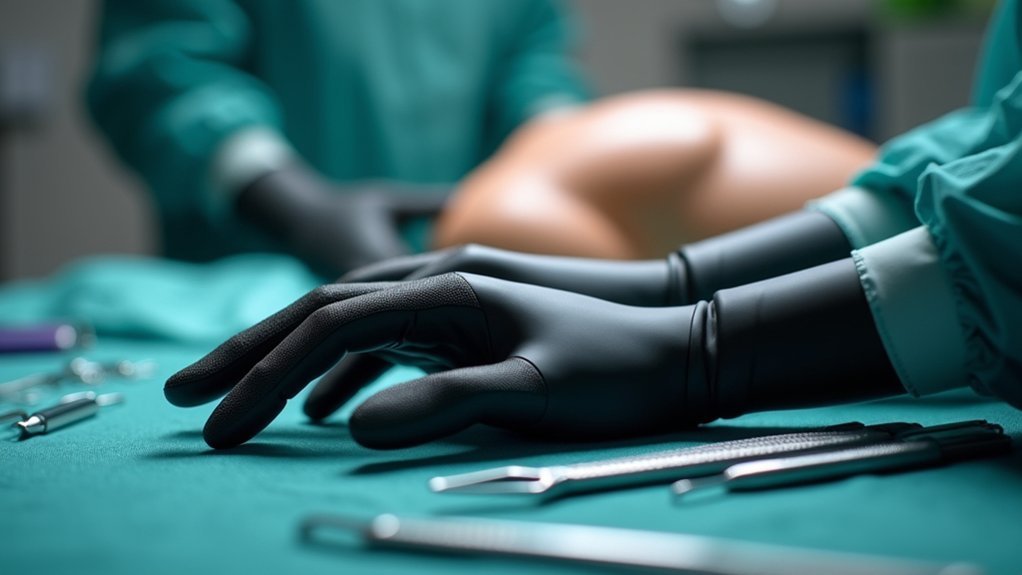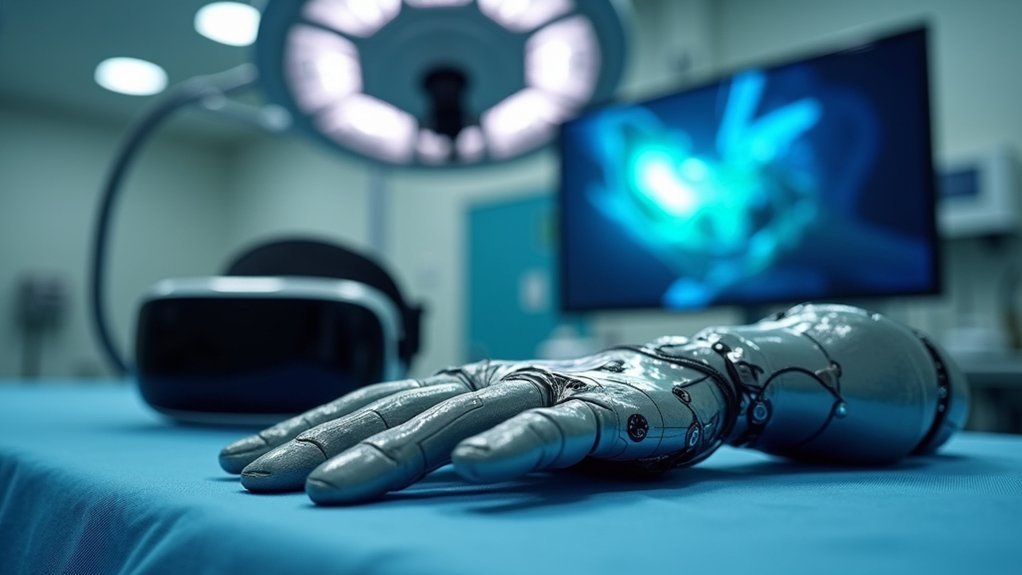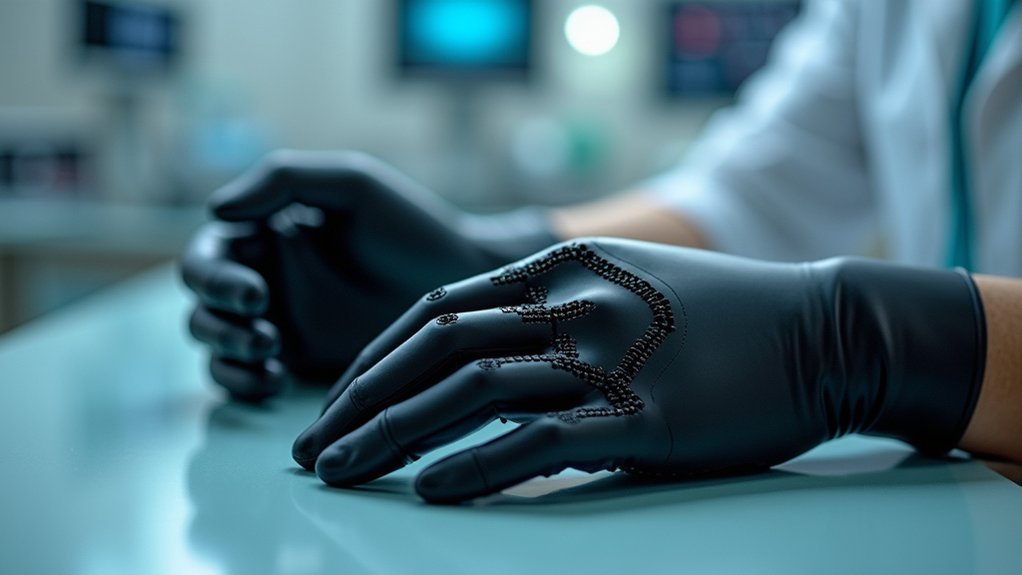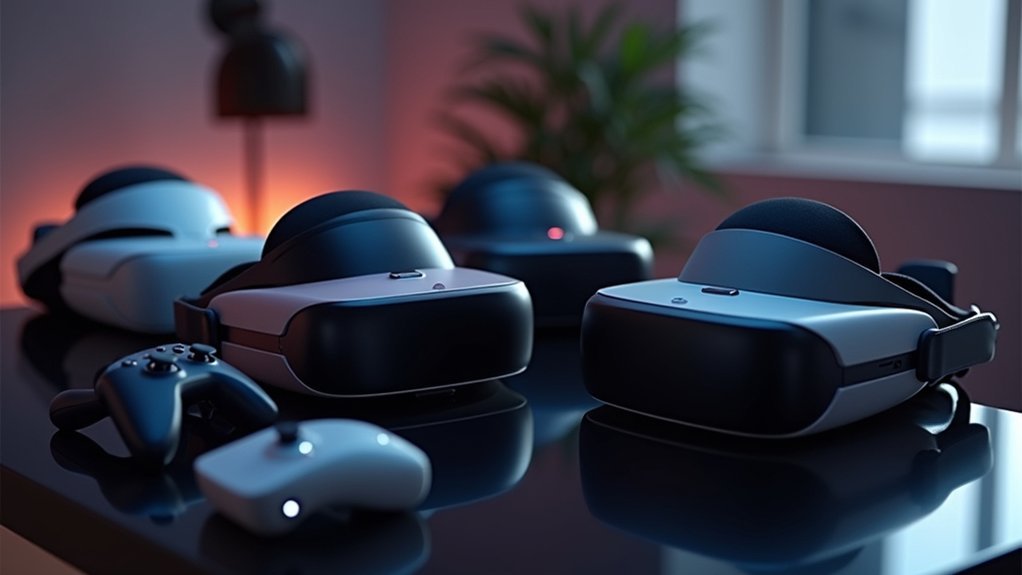Medical simulation haptic gloves are advanced wearable devices that revolutionize your virtual medical training experience through precise hand tracking and realistic force feedback. You’ll feel authentic tactile sensations that replicate tissue resistance, instrument weight, and different textures during surgical simulations. These gloves use fiber-optic cables or conductive ink for motion capture, while force actuators generate up to 20 Newtons of resistance within milliseconds. They’re transforming how you learn complex procedures risk-free while our detailed guide reveals their full potential.
How Medical Simulation Haptic Gloves Work

Medical simulation haptic gloves transform virtual medical training by combining sophisticated sensors with force-feedback actuators that recreate the physical sensations you’d experience during real procedures.
These VR gloves utilize fiber-optic cables or electronically conductive ink for precise hand tracking, monitoring every finger movement in real-time. The haptic feedback system generates tactile sensations that replicate tissue resistance, instrument weight, and various textures you’d encounter during surgery.
Through fiber-optic sensors and conductive ink, these gloves track precise finger movements while delivering realistic tactile feedback mimicking surgical textures.
Advanced models from companies like HaptX and SenseGlove deliver multiple points of tactile feedback across your hands, creating truly immersive experiences.
When you interact with virtual organs or surgical tools, the gloves respond instantly with appropriate force and texture feedback.
Wireless connectivity guarantees seamless integration with VR systems, enabling natural interactions that enhance medical training effectiveness through realistic simulation environments.
Key Components and Technology Behind Haptic Feedback
You’ll find that haptic gloves rely on two critical technological foundations to deliver realistic tactile experiences.
The sensor technology captures your precise hand movements through fiber-optic cables and electronically conductive ink, while force actuator mechanisms generate the physical sensations you feel.
These components work together to translate your interactions into immediate tactile responses that mirror real-world medical procedures.
Sensor Technology Fundamentals
Beneath the fabric surface of haptic gloves lies a sophisticated network of sensors that transform your hand movements into digital signals and convert virtual interactions back into physical sensations.
This sensor technology employs fiber-optic cables and electronically conductive ink to achieve precise finger tracking throughout your VR environments. The motion capture system detects real-time hand and finger positioning, enabling natural interactions during medical simulations.
When you touch virtual objects, these sensors generate tactile responses that simulate pressure, texture, weight, and temperature with remarkable accuracy.
Advanced haptic feedback delivers detailed responses like 20 Newtons of resistance within 10 milliseconds, creating immersive training experiences that closely mirror real-world medical procedures and patient interactions.
Force Actuator Mechanisms
While sensors capture your hand movements and detect virtual interactions, force actuator mechanisms transform these digital signals into physical resistance and feedback that you can actually feel.
These haptic technologies employ magnetic friction brakes and advanced actuators to deliver force feedback technology with resistance within 10 ms, creating real-time sensory experiences.
Modern medical simulation gloves use multi-modal haptic feedback, combining vibrotactile and force feedback to replicate authentic textures and pressures.
Here’s what makes them revolutionary:
- Lightning-fast response – Feel virtual objects instantly without delay
- Precise weight simulation – Experience genuine density and mass of medical instruments
- Independent finger control – Each digit receives customized tactile feedback
- Texture replication – Feel heartbeats, tissue consistency, and surgical materials
This technology bridges digital interactions with physical sensations, enhancing your training effectiveness.
Applications in Surgical Training and Medical Education

As medical education evolves toward more immersive learning experiences, haptic gloves are transforming how surgical trainees develop their skills. TouchDIVER Pro and similar devices provide lifelike force feedback and texture rendering, enabling you to practice complex procedures in risk-free virtual environments.
This VR training with tactile feedback markedly improves your skill acquisition, enhancing task performance and knowledge retention. You’ll experience realistic sensations like instrument pressure and tissue texture, vital for developing hand-eye coordination and dexterity.
These immersive simulations facilitate collaborative scenarios where multiple users engage simultaneously, enhancing teamwork and communication skills. Research demonstrates that haptic gloves reduce learning curves for new procedures, better preparing you for real operating room situations through thorough medical education experiences.
Benefits for Patient Rehabilitation and Therapy
Beyond surgical training, haptic gloves revolutionize patient rehabilitation by creating immersive therapeutic environments that accelerate recovery for stroke and spinal cord injury patients.
These advanced devices provide essential haptic feedback and tactile feedback, enabling you to distinguish between objects and practice movements vital for regaining motor skills post-injury.
Research demonstrates significant improvements in functional ability and quality of life when you use virtual reality gloves during therapy.
The technology offers remarkable benefits:
- Reduced hospital stays through enhanced engagement in rehabilitation exercises
- Greater independence as you practice daily tasks without constant therapist supervision
- Accurate movement tracking via advanced sensors for realistic virtual environments
- Natural interaction patterns that promote effective motor skill recovery
This immersive therapy approach transforms traditional rehabilitation methods.
Enhanced Realism Through Force Feedback and Tactile Sensations

You’ll experience unprecedented realism when haptic gloves deliver precise force resistance that mimics the actual weight and density of surgical instruments and human tissues.
The technology generates up to 20 Newtons of resistance within just 10 milliseconds, letting you feel authentic tactile feedback as you interact with virtual medical environments.
This force resistance technology works alongside tactile surface simulation to recreate the exact pressure, texture, and temperature sensations you’d encounter during real surgical procedures.
Force Resistance Technology
The subtle resistance you feel when gripping a scalpel or palpating tissue transforms virtual medical training from a visual exercise into a genuinely immersive experience.
Force resistance technology in force-feedback gloves creates authentic tactile feedback by generating up to 20 Newtons of resistance within milliseconds. This haptic technology simulates the weight, texture, and density of virtual objects, allowing you to experience realistic sensations during medical procedures.
Advanced force-feedback systems deliver:
- Immediate resistance feedback that mirrors real surgical instrument handling
- Precise pressure simulation for delicate tissue manipulation training
- Vibrotactile responses that replicate different textures and temperatures
- Enhanced muscle memory development through repetitive realistic interactions
This precision in force resistance technology markedly improves your training outcomes by developing intuitive understanding of instrument handling and patient interaction.
Tactile Surface Simulation
Precision in tactile surface simulation allows you to distinguish between the firmness of bone and the softness of muscle tissue through sophisticated haptic feedback systems.
These haptic gloves utilize force feedback technology to replicate virtual object density and texture, creating an immersive experience that mirrors real-world medical training scenarios. You’ll feel sensations of weight, resistance, and temperature as you interact with virtual surgical instruments and anatomical structures.
Advanced gloves like the SenseGlove Nova generate up to 20 Newtons of resistance within 10 milliseconds, enabling you to experience nuanced surgical procedures.
Vibrotactile feedback helps you differentiate between tissue types during virtual reality simulations. Research shows tactile feedback markedly improves your engagement and skill retention, better preparing you for actual clinical situations through enhanced realism.
Integration With Virtual Reality Medical Training Systems
When medical simulation haptic gloves connect with virtual reality training systems, they create immersive environments that revolutionize how healthcare professionals develop their skills.
These VR systems work seamlessly with haptic feedback gloves to deliver realistic tactile feedback during medical training scenarios.
You’ll experience transformative benefits through this integration:
- Feel genuine tissue resistance as you practice delicate surgical procedures, building muscle memory that translates directly to real operations.
- Train collaboratively with colleagues in shared virtual spaces, fostering teamwork and communication skills essential for patient care.
- Master complex procedures without patient risk, gaining confidence through repeated practice in safe environments.
- Accelerate skill acquisition through immersive simulations that engage multiple senses simultaneously.
Virtual reality combined with tactile feedback creates unparalleled training experiences that prepare you for real-world medical challenges.
Leading Manufacturers and Medical Haptic Glove Solutions
Several innovative companies have emerged as pioneers in developing medical haptic glove technology, each offering unique solutions that enhance virtual reality training experiences.
HaptX leads with high-fidelity gloves featuring over 130 tactile feedback points, perfect for medical simulation requiring precise touch sensitivity.
HaptX’s advanced gloves deliver unmatched precision with 130+ tactile points, revolutionizing medical simulation through exceptional touch sensitivity technology.
SenseGlove delivers impressive force-feedback technology providing up to 20 Newtons resistance within 10 milliseconds, making surgical training remarkably realistic.
VRgluv utilizes patented force feedback systems that allow you to accurately simulate complex surgical tasks during medical training sessions.
Teslasuit Gloves combine biometric tracking with motion capture, creating extensive solutions for rehabilitation applications.
Motive VR Gloves focus specifically on surgical training enhancement, providing detailed haptic feedback that facilitates realistic interactions within virtual surgical environments, ensuring you’ll experience authentic tactile sensations.
Advantages Over Traditional Medical Training Methods
You’ll find that medical simulation haptic gloves offer distinct advantages over traditional training methods, particularly in creating environments where you can practice without real-world consequences.
These advanced systems let you develop surgical skills through repeated practice of complex procedures, all while eliminating the risks associated with training on actual patients.
You’re able to refine your techniques and build confidence in a controlled setting that responds realistically to your touch and movements.
Risk-Free Practice Environment
Medical simulation haptic gloves transform how you’ll practice complex procedures by creating a completely risk-free environment where mistakes don’t endanger patients.
This haptic VR technology eliminates the anxiety of potentially harming someone while you’re learning, allowing you to focus entirely on skill development through immersive experience.
Virtual reality technology with tactile feedback creates training simulations where you can:
- Make critical errors without devastating consequences that haunt your career
- Practice high-stakes procedures without the crushing pressure of patient safety
- Repeat challenging techniques until muscle memory develops naturally
- Build confidence before entering real operating rooms where lives depend on your skills
These medical education innovations provide the psychological safety you need to push boundaries, experiment with techniques, and truly master procedures before moving to actual patient care.
Enhanced Skill Development
Beyond creating a safe learning space, haptic gloves revolutionize how you’ll master medical procedures by delivering advantages that traditional training methods simply can’t match.
When you use haptic gloves, you’ll experience realistic tactile feedback that lets you feel pressure and texture during procedures. This immersive VR training greatly improves your task performance and knowledge retention compared to conventional techniques.
You’ll develop vital hand-eye coordination and dexterity faster than training with static models or passive observation. The technology reduces learning curves for complex procedures, allowing you to refine techniques through repeated practice.
Medical professionals using haptic gloves demonstrate enhanced skill acquisition, as the realistic sensations prepare you for real-world scenarios more effectively than traditional methods ever could.
Current Limitations and Challenges in Medical Haptic Technology
While medical haptic gloves represent a promising advancement in healthcare training, they’re currently facing significant barriers that limit their widespread implementation.
The haptic technology struggles to deliver realistic feedback that matches real-world medical scenarios, leaving you with incomplete training experiences.
Current haptic gloves fail to replicate authentic medical sensations, creating gaps in essential hands-on training for healthcare professionals.
Key challenges hampering progress include:
- Prohibitive costs – Advanced gloves remain financially out of reach for many institutions.
- Time-intensive calibration – Extensive setup requirements discourage usage in fast-paced environments.
- Connectivity failures – Latency issues disrupt the seamless interaction you need for effective learning.
- Limited accessibility – High barriers prevent widespread adoption across training programs.
These glove design limitations mean you’re often working with technology that can’t accurately replicate essential sensations like weight, texture, and temperature, undermining the training’s effectiveness.
Future Developments in Medical Simulation Haptic Devices
As researchers push past today’s technological barriers, you’ll soon experience medical haptic gloves that harness advanced AI algorithms to create unprecedented training realism.
These technology advances will enable intuitive gesture recognition in virtual reality environments, making your interactions more natural and effective.
You’ll benefit from lightweight, wireless designs that enhance mobility during training and rehabilitation sessions.
Future haptic gloves will integrate biometric monitoring to track your physiological responses in real-time, optimizing learning outcomes.
The tactile feedback will expand beyond basic touch to include temperature and texture sensations, creating incredibly realistic surgical simulations.
As these innovations mature, you’ll find haptic gloves becoming standard equipment in medical education across specialties including surgery, rehabilitation, and emergency response training, fundamentally transforming how healthcare professionals learn and practice.
Frequently Asked Questions
What Do Haptic Gloves Do?
You’ll feel tactile sensations like texture, pressure, and temperature through force-feedback actuators. They’ll track your finger movements precisely, letting you interact with virtual objects as if they’re real physical items.
How Much Do Haptic Gloves Cost?
You’ll find haptic gloves cost between $500 to over $10,000. Entry-level models start around $500-$1,000, mid-range options cost $1,500-$5,000, while high-fidelity professional gloves exceed $10,000 depending on features.
What Is a Haptic Simulator?
You’ll experience realistic touch sensations through a haptic simulator, which uses tactile feedback technology to let you interact with virtual objects. You’ll feel resistance, texture, and forces while practicing procedures in safe, simulated environments.
How Much Do Haptx Gloves Cost?
You’ll pay approximately $10,000 to $20,000 for HaptX gloves, depending on the model and features. You’ll also need to budget for additional software integration and training services required for implementation.
In Summary
You’ll find medical simulation haptic gloves transforming how you learn and practice medical procedures. They’re revolutionizing surgical training by letting you feel realistic tactile feedback during virtual operations. You can develop muscle memory and refine techniques without risking patient safety. As technology advances, you’ll see these gloves becoming more affordable and accessible, making high-quality medical training available in more institutions. They’re reshaping the future of medical education and patient care.





Leave a Reply